The Aira team is delighted to welcome Robin Lord as Head of Innovation.
Robin has a rich digital agency background at places like Distilled, where he progressed from Analyst to Senior Consultant, and Brainlabs, where he was Acting Head of SEO.

Digital marketers will probably also recognise Robin from his widely published writing for sites such as Moz, and his talks at industry events like Learn Inbound, Searchlove and SMX.
He joins us to supercharge innovation at Aira, creatively pushing us to be the best we can be across all services - from SEO and paid media to digital PR, inbound marketing and beyond.
Robin will be focusing on anything and everything that can help us get faster, better results for our clients. Whether that be automation, technical knowledge, consulting practice or strategy.
Robin said:
‘I'm very excited to join such a talented and passionate team. Aira already has a lot of awesome projects in the works and I can't wait to be involved.’
Matthew Kay, Aira’s Growth and Strategy Director, commented:
‘Bringing on someone of Robin's calibre is a leap forward for Aira. He'll add something that we've not had before - working across teams to help create tools and enhance existing processes that improve efficiencies and outputs which will lead to one thing - business and revenue growth for our clients. Welcome Robin!’
Back in 2012, I wrote a blog post for Moz which gave away a little cheatsheet for anyone who wanted to make sure that all of the basics are covered when it comes to product pages on retailer websites. Whilst many of the fundamentals that I covered back then will still apply today, I felt that it was time for an updated cheatsheet which you can find below along with extra context for each element of the page.
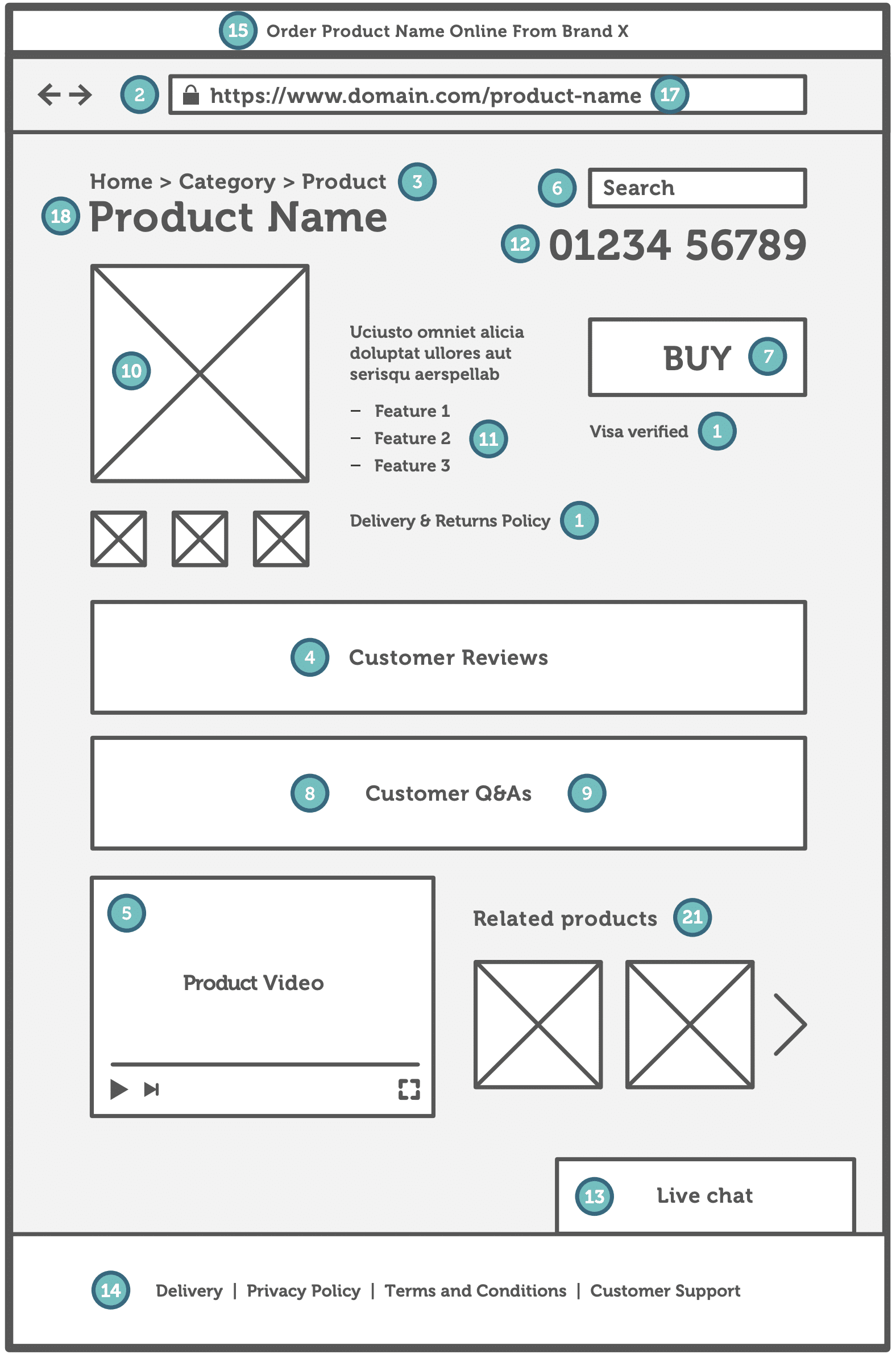
Note that whilst most of the numbers relate to the cheatsheet, there are a few which are hidden from view such as Open Graph tags and responsiveness.
You can read more about each element below, along with a link to read more if you'd like to, plus a link to an ecommerce website that's a good example of the element highlighted.
1. Trust Signals
What trust signals is someone looking for in your site? Credit card security? Phone number? Delivery details? Make sure you provide them where you can and make them clear. When a customer is looking at your page, they need to feel that you're legitimate and that they can trust you with their credit card details and to deliver the product to them.
2. HTTPS/SSL
The standard for all sites, essential for ecommerce websites. Ensure all URLs are served via HTTPS protocol and keep certificates up to date so that the transmission of customer information is as secure as possible.
3. Category breadcrumbs
Provide a clear breadcrumb trail to show users where they are in your category structure, making it easy for them to browse products and click between categories easily.
4. Customer reviews
A great form of user-generated content - publish customer reviews on your product pages and use Review Schema on them. If you're using a third-party system, ensure that the review content is crawlable and unique to you, i.e. not duplicated elsewhere on the web.
5. Product videos
Videos offer additional insights into your products, showing finer details and use cases. Consider using a custom hosting platform such as Wistia for hosting and embedding, so that you can customise a video and add your own branding.
6. Search options
Provide a clear, fast search box if someone would rather navigate your website by a search. Ensure that results are accurate and comprehensive whilst accounting for misspellings and grammatical errors.
7. Clear call to action
Ensure that Buy buttons are clear, easy to click (particularly on mobile) and use analytics tools to record behaviour on product pages so that you can spot problems and refine the process of buying from you.
8. Microdata and Schema
The Schema.org library of microdata has a range of options for marking up product pages such as price, description, reviews etc. Implement the markup and help Google understand your content better.
9. Q&A content
Another great form of user-generated content and particularly useful for technical products. Allow customers to ask questions and get your team (and the community) to answer. This content can also be used by other teams in your organisation such as sales, marketing and customer support.
10. Images
Provide clear, sharp, high-quality photos of your products. If possible, make them customised to you and include lifestyle/use-case images too. Also try to avoid using obvious stock photos for your products.
11. Product description
Don’t think about 'SEO copy', think about accurately and succinctly describing your product. Include use cases, bullet point summaries and technical information to help the user understand the product.
12. Phone number
Another strong trust signal. Provide a clear phone number and opening hours so that customers can get in touch quickly and easily.
13. Live chat
Provide live chat functionality for real-time customer support for people who don’t like using the phone.
14. Address and company details
Include your physical address, company registration number and VAT number/Tax ID. Not only do these help show you’re a real, legitimate business, but some B2B customers may require them for purchasing.
15. Page title
Include the product name and USPs where possible such as Free Delivery or Next Day Delivery to entice clicks from search results. Use database variables to scale the creation of page titles across your site if it is a large one.
16. META description
Treat this like a mini-advert for the product. Include the product name and USPs to show the value of it and increase the chances of someone clicking through to it. If you run Google Ads, borrow elements of the copy that works best for clicks and add them to your META descriptions.
17. Page URL
Include the product name, avoid database driven parameters and keep them human-readable. Avoid including the category in the URL if products are in multiple categories, because this can lead to duplicate product pages.
18. Header tags
Use an H1 tag for the product name and H2+ tags to break up sections of the page such as reviews and copy.
19. Open Graph Tags
Include Open Graph tags and ensure they reference clear images and copy so that social sharing of your products is as effective as possible.
20. Responsiveness
Ensure that all key elements of your page load correctly on mobile devices and that entering personal details is as easy as possible.
21. Related products
Include links to similar, popular products to help users compare them and decide which one is best for them.
Bonus - 22. Page speed
No one likes a slow website, even less so if you’re looking to buy something. Ensure your pages load quickly across desktop and mobile devices.
In one of the most surreal moments ever, Rudy Guilliani accidentally delivered a speech from the parking lot of Four Seasons Total Landscaping in Philadelphia. The booking error led to a huge wave of news articles talking about Four Seasons Total Landscaping, including articles in The New York Times, The Guardian and USA Today.
Guess what.
Most of these websites linked to the Four Seasons Total Landscaping (FSTL from now on!) website too. I remember tweeting back and forth at the time with Patrick Stox and talking about how this may play out long-term for them in terms of organic search. Patrick updated the tweet thread until December at which point, things appeared to have settled.
I decided to have a look and see how they were doing now. Patrick also helped me with a review of this post prior to publishing - thank you!
Some context
There are a few things that make this an interesting case to take a look at from a link building perspective.
Firstly, we’ll see that FSTL received a large spike in links which quickly dropped off once things died down. A few links kept coming in over the course of a few weeks but the biggest spike happened within the first few days of the press conference. Conventional wisdom tells us that without sustaining links, any spike in organic traffic and rankings may only be temporary.
Secondly, we come back to the lovely topic of link relevancy which I happened to write about here last week. The links generated at this time were not from websites that relate to what FSTL actually does. If we use the Google Natural Language API to take a peek at what Google thinks their content is about, we get this:

Unsurprisingly, "landscaping business" is the topic that has the highest salience. The only one that sticks out is "press conference" which is mentioned once in the copy that I took from their homepage. It still has a pretty low salience though and I don’t think this is quite enough to make this a key topic for the page or domain as a whole.
The key point here is that most of the links generated to FSTL during this period are not from websites that focus on landscaping, grounds maintenance, lawns, or any of the topics above.
Does this mean that the links won’t have helped? We'll see.
The third reason that this is an interesting case to look at is that it’s akin to a brand going viral in both the speed of links that were acquired and the fact that links aren’t completely relevant. If it had been a deliberate act by FSTL, it would probably be described as a PR stunt. And a moment of genius.
Given that this is an approach used by many brands and agencies, it is worth looking into in order to understand the potential impact on their organic search traffic and rankings.
Right, so let’s see what happened.
When it all kicked off
The press conference took place on 7th November 2020 and we can see a clear spike in new referring domains in Ahrefs:

They went from around 24 referring domains on 6th November, to over 500 about a month later. Here is the day by day breakdown, remember that this is only when Ahrefs discovered the links, so there is likely to be a little bit of a lag here:

Taking a closer look at where these links came from, it reads like a link builder’s dream:
- The Guardian
- The New York Times
- Business Insider
- Buzzfeed
- Rolling Stone
- NME
- Wired
The list goes on.
In summary, FSTL gained a large number of new links and 20x the size of their link profile in the space of a month, but the vast majority of these new links were from high authority domains. Of course, there is some low-quality stuff in there too, but that always happens when you get links on large news websites because they get scraped all the time. I’ve rarely seen this hurt a brand and Google seems pretty good at detecting these types of links.
The drop off in links, but not really
As you can see above, referring domain numbers spike sharply and then drop off towards the end of November. However, they have continued to generate new links almost every day since the drop off and are now generating far more links than they ever have before.
Between January and October 2020, FSTL generated 21 new linking domains, losing 9 in the process, leaving us with a net increase of 12 linking domains in 2020, prior to Rudy’s visit.
Between November 2020 and mid-February 2021, they have generated 730 new referring domains, whilst losing 127; a net gain of 603 referring domains in the space of just over three months.
Yes, there was a huge spike in links which quickly dropped off, but their link velocity now is far, far higher than it’s ever been before. The links coming in now are along similar lines i.e. not particularly relevant to landscaping or gardening and mostly covering the fame that FSTL has achieved.
So, even if we put aside the viral aspect of the links that were generated, FSTL are still benefiting from this accidental 15 minutes of fame when it comes to link generation. They are also trying their best to ride the wave and take advantage of it which I’ll talk about shortly.
What happened to their traffic and rankings
Now, a couple of caveats (I’m an SEO, of course I have caveats).
- I’m using third-party data to try to assess the impact of these links on FSTL traffic and rankings. Ahrefs provided the largest dataset to work from, which is why I chose to use them.
- Selfishly, FSTL relaunched a newly designed website recently which, from what I can tell, is far better than their old one. It appears that this new website was launched just a few weeks ago in early February, so I’ve tried to limit my analysis and takeaways to before this point. This should help us isolate the impact of links a bit better.
So, what happened?
Well, broadly, this - which is the Ahrefs graph for their estimated organic traffic:
 It’s not a huge dataset to work with (that may be my third caveat) but it’s something. We can see the big spike in organic traffic which appeared to start around the 10th/11th November, which is a few days after the press conference took place.
It’s not a huge dataset to work with (that may be my third caveat) but it’s something. We can see the big spike in organic traffic which appeared to start around the 10th/11th November, which is a few days after the press conference took place.
It’s then pretty up and down and drops off quite a bit at the end of December/start of January. We then see another spike around 21st/22nd January which is a bit higher than the original spike. There may be other reasons for this related to some technical changes they made to their shop, which we’ll look at shortly.
From this point onwards, things are up and down a fair amount and we know that they relaunched their website which will have also played a part in the spikes we see. So we can’t have too much confidence in isolating the impact of the links they gained during the period after the new website launched.
At first glance though, it would appear that they’ve benefitted a fair amount from the accidental 15 minutes of fame and the links they generated as a result.
We need to go a bit deeper though to try and see what really happened. We can do that by looking at the keywords that have caused these spikes and dips in organic traffic.
Keyword movements
The first thing to mention is that there appears to have been a small cost of fame. FSTL is a little all over the place when it comes to ranking for their own brand name. Taking [Four Seasons Landscaping] as an example, they are currently around the bottom of page 1 in the US results for this and appear to be bouncing around the whole of page 1. Their recent involvement in a Super Bowl advert also appears to have shaken things up more, with news stories ranking ahead of them.
Search volume for their brand has also increased hugely since the press conference, with Ahrefs now reporting 11,000 monthly searches for this one keyword. This means that movements up and down page 1 can affect how organic traffic is reported and often lead to the spikes that we see.
Putting branded keywords to one side, let’s take a look at a few non-branded keywords and see how they are doing.
You can see that I’ve filtered rankings to see how they were performing as of 31st October (prior to the press conference) and compared to 31st January which is before they redeveloped their website. I’ve also filtered to exclude branded keywords and variants.

You can see that FSTL is ranking much, much better than they were previously. Not all of the keywords are on page 1, but they’ve essentially gone from nowhere to being there or thereabouts.
Taking [landscaping philadelphia] as an example, we can see pretty clearly where the ranking movements happened. Note that ranking position reporting here isn’t at the local level, so the numbers we see don’t take into account someone being in Philadelphia.

And here is how [landscaper philadelphia pa] looks:

There is no telling what happened after January 2020 to see them drop out in this way, but we can certainly see that they reappeared prior to the influx of new links, then saw a nice little bump onto page 1 in early November.
And finally, this is how they’re doing for [philadelphia landscaping]:

Again, something clearly went wrong early in 2020 for them, before a return in October and a lovely little bump on to page one after the press conference.
Let’s bring it all together
The question - did the influx of links play a part in the increase in rankings that we’ve seen for non-branded keywords?
In my opinion, they almost certainly did and continue to play a part. Whilst the search volumes are somewhat modest and there is still lots of movement in rankings, I’d point to the specific keyword improvements above, along with this, which is Ahrefs estimate on their organic traffic, based on rankings and search volume:

This will include branded search, which we know has increased massively and will play a part. But I think there is enough movement on non-branded keywords to be reasonably confident that links have played a strong role here. I gave three examples above, but there are plenty more that follow a similar pattern.
It should also be noted that they appeared to move their shop offsite to another domain which has also played a part in the lifts and drops that we see here. In fact, they now appear to have the chance to reclaim 400+ linking root domains as a result of this which are 404ing. Link building sad face.
Could there be more at play?
Of course, it’s SEO. We will never, ever know the full picture even when the website belongs to us and we have access to all of the data. I mentioned earlier that FSTL is certainly riding the wave and from what I can see, doing a great job of it. Not only were they involved in a Super Bowl advert, but they are also not afraid to play on their 15 minutes of fame on their social media accounts. Not to mention that they also have an upcoming documentary and have launched a line of merchandise.
Is the increase something I’d expect given that their link profile has grown 20x in the last few months? Probably not to be honest, but this comes down to what they do and the size of the market they are pursuing. Despite worldwide fame, they are a local landscaping company and will only really be deserving of ranking for keywords related to this. These keywords naturally have volumes that are not massive, so they were only ever going to grow their search visibility and traffic by a certain amount.
We should also note that their search visibility and rankings previously weren’t exactly great, so there was arguably only one way to go. Although I would still point out that they were ranking ok for some relevant, non-branded keywords throughout September and October.
Another point here, raised by Patrick at Ahrefs, is that perhaps the sheer number of major news network links weren’t the big influencer here. FSTL also got a bunch of links from local networks, as well as a handful of niche-specific ones. After all, these stories will have quickly been buried under lots of other news items, whereas this isn’t as common with local and niche-specific links.
Lessons we can take from this
Well, pray that you’re the next company on the receiving end of a phone call from the lawyer of a US President who needs a press conference venue.
Aside from that golden nugget of advice, I think this all tells us a few things:
- Links matter.
- The relevancy of the links didn’t seem to mean that the links weren’t valuable or impactful, although this is obviously hard to isolate i.e. would they have done even better if the links were from garden and landscaping domains?
- The impact you see is likely to be proportional to where you are right now vs. the size of the opportunity in your market. 500 new links for one brand will mean something entirely different to another.
- Having campaigns that can lead to links similar to the ones FSTL generated is likely to add value to your brand, but isn’t likely to be the silver bullet that makes you rank for everything you want to. There is more to it than that and FSTL can still improve on where they have gotten to today.
- Links matter.
The strategic approach to link building
Looking at strategy for brands, I'd say that there are two core things to think about if you see link building as part of your growth strategy:
- You need to think about how to make your website deserving of links that you didn't ask for, therefore reducing your reliance on the next point. This is hard unless you're one of the top 100 brands in the world. Long-term, you don't win at link building by having the best campaign ideas or outreach. You win by getting links that you didn't ask for.
- This doesn't happen overnight. So in the meantime, you need to think about not just making your website link worthy, but having the creativity and relationships in place to generate links that you wouldn't otherwise get. Proactive content-led link building campaigns are one way to do this.
Not sure if you need to think about link building as part of your growth strategy? Drop me a message and I'll tell you honestly if it should be or not. Spoiler: it's not the best use of time and budget for everyone - not every agency will tell you that. We will.
A Customer Relationship Management (CRM) system provides a central place where businesses can manage customer and prospect data.
If you’re a business looking to implement a new (or replacement) CRM, there are thousands of solutions on the market. It’s not an easy process to evaluate and compare. In fact, one of the questions we're most frequently asked is, ‘what CRM should I use?’.
It’s important to start by saying that there is no best CRM. The right CRM for your business depends on the size of your company, your budget, the structure of your business, your current technology and even your employees.
With that said, two of the most popular CRM systems are HubSpot and Salesforce, and in this post we’ll compare and contrast the two to see which might suit your business best.
HubSpot vs Salesforce CRM
Salesforce has become one of the world's most renowned CRM providers. Launched back in 1999, it revolutionised the CRM software industry with its cloud-based solution Sales Cloud.
In terms of market share, Salesforce is the leader with a 19.6% market share and over 150,000 customers.
HubSpot introduced their free CRM software in 2014, allowing businesses to organise, track, and nurture their leads and customers.
Salesforce is the global leader in CRM but HubSpot is slowly gaining traction, especially among small-medium sized businesses, and now boasts more than 56,500 customers.
When choosing a CRM, like HubSpot or Salesforce, it’s important to evaluate and compare certain areas. We’ll be evaluating both CRMs on the following:
- User interface
- Ease of use
- Pricing
- Features
- Reporting
- Customisations
- Integrations
- Support
By the end of this post, you’ll (hopefully!) be able to answer whether or not you should choose HubSpot vs Salesforce for your business’ needs.
User interface
When it comes to selecting a CRM for your business, the user interface (UI) is critical to the success of your implementation. If your salespeople aren’t entering information for sales calls, prospects and leads, or worse, entering bad data, they can create more work for your business.
HubSpot and Salesforce’s user interface is best evaluated by looking at screenshots of the different pages:
HubSpot
 (Source)
(Source)
Salesforce
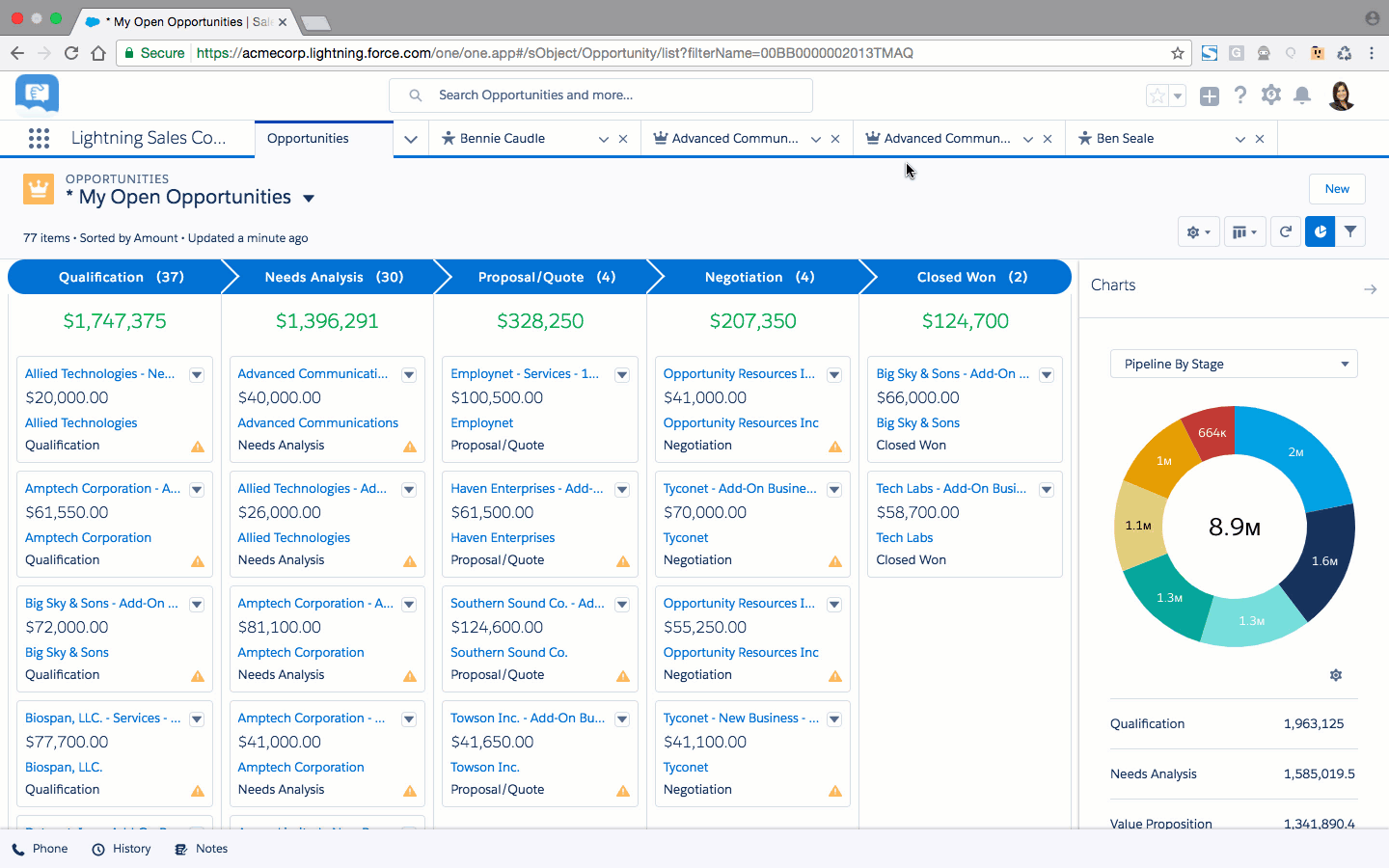 (Source)
(Source)
HubSpot
Salesforce
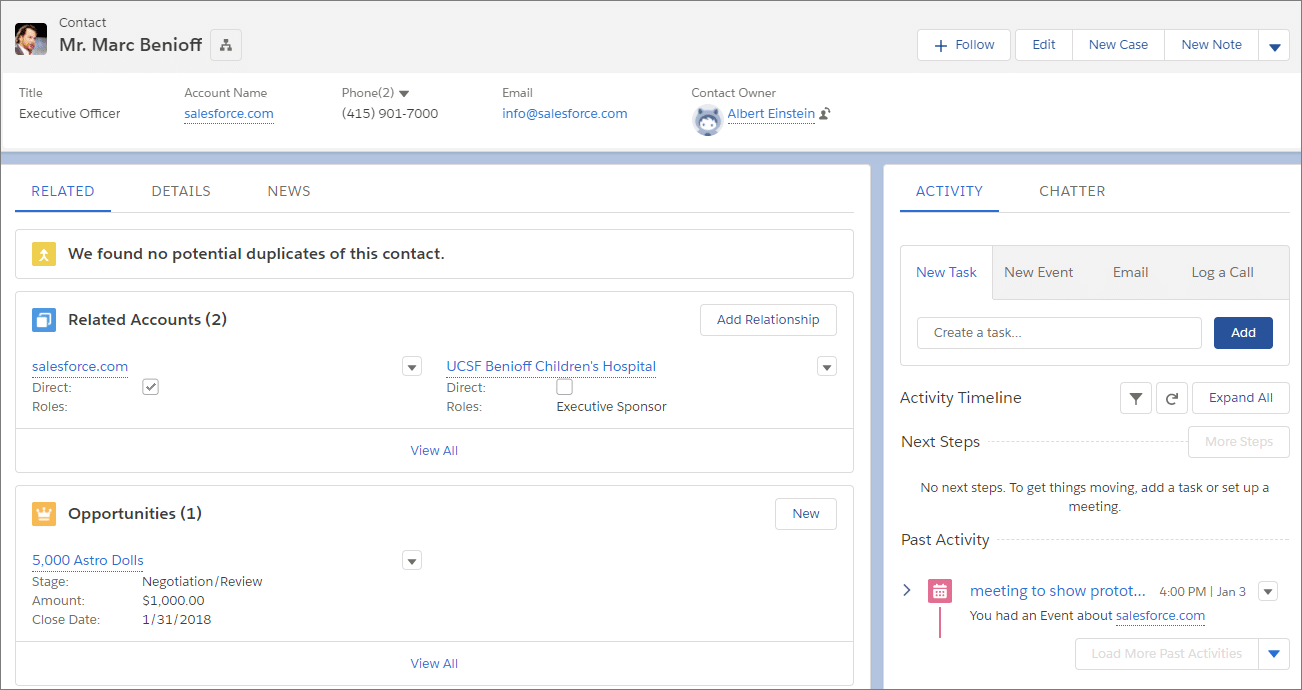 (Source)
(Source)
When it comes to evaluating UI, it’s important to accept that everyone has a different user experience so it’s very subjective. It all depends who looks at it and works with it.
With that said, one of the most common criticisms for Salesforce online is that its UI is clunky and looks outdated compared to other CRM providers.
Looking through Salesforce’s user reviews on TrustPilot, here are some of the comments:
'Interface looks like it's from the '90s!'
'Old and clunky user interface'
'There are and will be other Sales CRMs coming down the line offering a MUCH BETTER user interface'
Ease of use
With CRMs, the biggest challenge facing businesses is getting their sales and marketing teams to use the CRM day in, day out.
In terms of features and functionality, Salesforce is far more complex and comprehensive. While most customers will buy based on what a CRM can do, a common complaint about Salesforce is that, due to its complexity, businesses won’t use most of the features.
Due to the steep learning curve, many businesses don’t take advantage of what the system has to offer. It is user-friendly and has a modern UI, but its complexity can be overwhelming for some businesses.
HubSpot, on the other hand, is more intuitive for users and doesn’t require a huge time investment to get familiar with.
Here is a comparison between the HubSpot and Salesforce dashboards:
HubSpot
Salesforce
To give you an example, here’s a screenshot of the newer Salesforce dashboard.
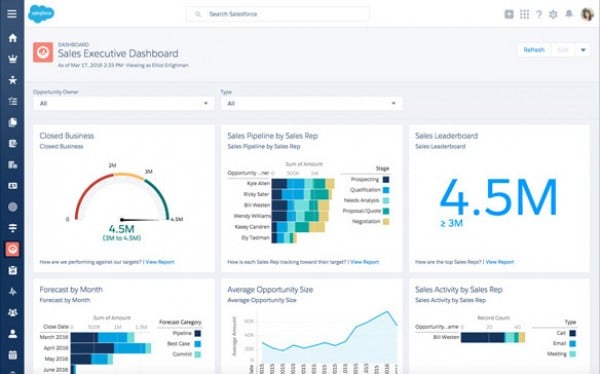
As you can see, there are a lot of tabs and buttons to press. You’d be forgiven for getting a bit lost in the interface.
Ease of use is ultimately subjective but based on data gathered by Capterra from real users in sales and marketing roles:
- Salesforce has a 3.9/5 average rating for ease of use by 14,230 users on Capterra.
- HubSpot has a 4.4/5 average rating for ease of use by 2,521 users on Capterra.
Pricing
When it comes to price, HubSpot's CRM is the winner over Salesforce.
Salesforce starts at £20/month per user for an out-of-the-box CRM, but this is only for up to five users. Beyond that, you can choose between three other packages:
- Essentials - £20/month per user
- Professional - £60/month per user
- Enterprise - £120/month per user
- Unlimited - £240/month per user
You can compare the different editions and features on Salesforce’s website, but for Lightning Professional the following are some of the features you get:
- Account and contact management
- Person Accounts
- Chatter
- Files
- Salesforce Mobile App
- Full offline mobile functionality
- Email Integration with Gmail or Outlook
- Google Apps integration
- Task Management, Activity Feed
- Opportunity management
HubSpot, on the other hand, is…. free. Yes, you read that right. You can add 1,000,000 contacts, unlimited users, and your free access to the CRM is never-ending.
If you want more functionality, HubSpot also offers the following:
- HubSpot Sales Starter - £42/month per user
- HubSpot Sales Hub Professional - £410/month with 5 users included
- HubSpot Sales Hub Enterprise £990/month with 10 users included
You can compare the different HubSpot products and services here, but HubSpot Sales Starter includes the following features:
- All Features of HubSpot CRM
- Email Scheduling
- Meetings
- Reporting Dashboards
- Live Chat
- Conversational Bots
- Sequences
- Documents
- Notifications
Hidden Costs, Fees & Add-ons
Along with the licensing costs, Salesforce includes many hidden fees and add-ons. These 'product enhancements' are sold separately and include the following:
- Knowledge user license
- Offline access
- Live video chat support
- Additional data storage
HubSpot, for the most part, functions as a free standalone CRM. The only added costs are the paid marketing and sales tools that are listed above.
- On Capterra Salesforce has a score of 4/5 for value for money.
- On Capterra HubSpot has a score of 4.4/5 for value for money.
Features
If we look at the most common features associated with CRM technologies, here is how both companies stack up:
| Features | HubSpot | Salesforce |
| Opportunity & Pipeline Management |  |
 |
| Territory Management |  |
 |
| Task Management |  |
 |
| Desktop Integration |  |
 |
| Customer Contract Management |  |
 |
| Product & Pricing Management |  |
 |
| Quote & Order Management |  |
 |
| Forecasting |  |
 |
| Reporting & Dashboards |  |
 |
| Social Collaboration |  |
 |
| Mobile App |  |
 |
| Output Document Generation |  |
 |
| Sandbox/Test Development Environments |  |
 |
| User Role & Access Management |  |
 |
| Customization |  (limited) (limited) |
 |
| Workflow Capacity Monitoring |  |
 |
| Internationalization |  |
 |
| Document & Content Management |  |
 |
| Integration APIs |  |
 |
| Data Import & Export |  |
 |
| Lead scoring |  |
 |
| Lead segmentation |  |
 |
| Predictive analytics |  |
 |
| Bi-directional CRM syncing |  |
 |
| Event management |  |
 |
| Create invoices |  |
 |
| Create quotes |  |
 |
| Split testing |  |
 |
| Sales reports |  |
 |
| Real-time sales alerts |  |
 |
| Mobile app |  |
 |
Comparing HubSpot and Salesforce features, it’s evident that Salesforce has more. With that said, it all comes down to your business' requirements.
- Salesforce scores 4.4/5 for features on Capterra.
- HubSpot scores 4.3/5 for features on Capterra.
Reporting
Salesforce wins for reporting. Salesforce allows you to customise and build hundreds of dashboards and reports, no matter the complexity.
You can, however, add an additional reporting functionality to HubSpot for an additional cost, which brings the platform’s functionality to a similar level to Salesforce.
If your business has an advanced need for sophisticated lead analytics and reporting, then Salesforce has a competitive edge. It’s also worth noting that in terms of exporting, Salesforce is again more advanced in this department. With HubSpot there are some clever features around exporting their dashboards to PDFs or PowerPoint, but Excel exports in certain areas are lacking, or difficult to get all of the data you need.
Customisations
Salesforce markets its product as 'the most customisable CRM'. HubSpot can also be customised for your business' processes and structure, as well as offering an Open API, but is likely not too customisable to the same extent as Salesforce.
With Salesforce, you can customise each of the standard tabs and types of records, including adding custom fields and setting page layouts. You can also customise the search, tagging, and user interface options for your business.
If you want a product that makes it easy to adjust the software to simply fit your business needs, HubSpot wins. If you want a product that allows seemingly endless customisation, Salesforce is the better solution.
Integrations
HubSpot allows you to integrate with hundreds of apps and services, including integration with WordPress, Survey Monkey, Zapier, Slack - and we think HubSpot’s LinkedIn ads integration is a game-changer for B2B marketing. This list is ever expanding, and their open API offering allows companies to build their own custom integrations.
Salesforce offers an ever large ecosystem with thousands of products and integrations via their AppExchange. AppExchange, which is known as the Salesforce Store, allows users to extend the functionality of Salesforce, whether that’s integrating outlook with Salesforce, sending documents with DocuSign, or creating email campaigns, managing your lists and subscribers all from within Salesforce with MailChimp.
CRM support
Salesforce licensing includes limited support. Their standard plan is available to every Salesforce customer, which includes the following features:
- 2-day response and 12/5 support (12 hours a day, 5 days a week) from their technical team
- Guided journeys
- Community forums
- Access to Trailhead, which is a series of online tutorials
- Events
- Interactive webinars
Salesforce also offers Premier, Premier+, and Priority plans offer additional guidance and support. The additional cost depends on the total price of purchased products.
HubSpot offers many different types of support all available to free users, including:
- Training courses
- Multiple certification tracks
- eBooks, whitepapers, and interactive downloads
- Knowledge Base
- Community forums
- The HubSpot Academy
If you upgrade and start paying for HubSpot products, you can access 24/7 phone and email support.
Which is the best CRM?
Salesforce and HubSpot are both great CRM options, but they have significantly different strengths and benefits. It’s important to understand how the features and other factors fit into your business' needs and budget.
After all, there is no right answer to the HubSpot vs Salesforce comparison. There is no best, rather it’s a case of which CRM is best for your business. Play around with the HubSpot and Salesforce dashboards and get a feel for them. See which you think you and your team would be more likely to feel comfortable with.
For many large businesses, Salesforce is the right CRM.
For many small and medium-sized businesses, HubSpot is the better option, but HubSpot have started rolling out more enterprise-level features over the last couple of years too.
As a HubSpot agency and inbound marketing agency, we lean towards their CRM platform because of its pricing, integration and features.
Try it out by clicking on the banner below if you like.
But Salesforce might still be the better option for your organisation. Let us know your preference or shoot over any questions on Twitter!
Back in August, Aira’s paid media team - headed up by Byron Marr - was lucky enough to be invited to join the new ‘Retail Digital Champions’ training programme, thanks to our status as a Google Premier Partner.
We are proud of our long-standing strategic partnerships with key channels such as Google and Facebook, with our very own Googler joining us to speak at our last MKGO event.
This programme in particular was focussed on maximising growth for ecommerce businesses, in preparation for the peak retail season.
It goes without saying 2020 was a year of rapid market change for businesses of all shapes and sizes. Consumer behaviour shifted even more to shopping online due to lockdown restrictions - as this article from McKinsey shows, ecommerce penetration grew the equivalent of 10 years in just 90 days during Q1 of 2020.
Needless to say with everybody shopping online, and a huge influx of new businesses being added to competition in ad auctions, a robust paid media strategy was essential to drive revenue and achieve business goals.
Our paid media team prides itself on being market-leading in the utilisation of machine learning and the adoption of the latest campaign formats, to drive the best return on investment for our clients.
Head of Paid Media at Aira, Byron Marr, commented on the team win:
“We were delighted to receive this award for being a ‘Top Performing UKI agency’ having successfully graduated at the top of the programme. The introduction of machine learning into paid media platforms has been significant over the past 18 months so being up to date with how to best utilise these tools is a must for generating the best ROI. I am proud to see our team as always embracing these changes and maintaining their industry leading level of knowledge on the topic.”
Whether you are new to PPC or not, there are a few things you should know when it comes to learning. Below are 5 important points that helped to speed up my personal learning and growth with PPC during my first year working at an agency.
1. Doing is effective for learning
It may sound obvious, but having a ‘jump-in’ mentality is important when learning PPC for the first time. There is a huge range of amazing training resources out there to broaden your knowledge, but putting this theory into practice is often the best way to learn.
I remember opening up our Google Ads manager account for the first time and being blown away by the amount of information on the platform. There is a huge range of tools and navigation buttons, and at first, it was easy to get lost in the platform. It can be a lot - but just navigating through one section at a time really helped get a deeper understanding and also sped up my training progression.
Getting hands-on with PPC isn’t just great for retaining information, but also vital in building confidence in your ability. It’s fair to say that the first campaign I ever built took a long time to create and I was nervous to publish it in case I’d missed something. By the second build I already had a ton more confidence and fast forward to today, it feels like second nature. Increasing confidence in your ability isn’t possible from just reading learning materials.
Getting straight into the practical work helps you get familiar with your accounts. You need to be able to notice the trends in the data for two main reasons:
- To spot problems in the account and swiftly resolve them.
- Analyse performance and discover opportunities.
The quicker you get into an account and learn it’s behaviour, the better the service you provide to the client.
2. Understanding business goals (leads and revenue) as measurements of success
At Aira we optimise everything to the client’s business goals. This means focusing on the metrics in the account that really matter, typically either revenue or qualified leads. A common mistake when measuring performance is to get caught up in secondary metrics such as impression, clicks, CTR and even quality score.
These types of metrics can of course indicate positive or negative performance, however, without the context of other metrics such as revenue or leads alongside, they often only tell half of the story - which isn’t what you want if you’re optimising or looking to scale.
For example, a drop in clicks, can be a positive thing in some cases. If fewer clicks are still achieving a similar volume of conversions (or more) it means your ads are targeting more relevant users. This is something we often see when we implement smart bidding.
Staying focussed on business goals as a measurement of success and then tracing back to indicative metrics when required, keeps you focussed on driving a great return.
3. Old vs new - learn the old to help understand the new
Learning the roots and older practices, such as segmenting by match type, is a great way to understand how paid search developed to where it is now.
Older methods of PPC are also useful for when you receive a new client account. Not all accounts will be set up for success in the current day. It’s important to be able to recognise these campaign layouts to help understand the process of modernising the account to give the client the best service possible.
An example of a legacy PPC method is separating different keyword match types into different ad groups or campaigns. This was a common practice in PPC that allowed more control over bidding, budgeting and targeting in an account. It allowed us to write copy based on the user's intent. For example, someone who searches ‘buy a computer’ is likely to have more intent to purchase than someone who searched ‘why should I buy a computer, as this could imply that they are still discovering their options.
An exact match keyword of this search term would be able to target lower funnel users that have a higher intent to purchase. You can then tailor your copy to the specific audience. Your phrase match keywords for ‘buy a computer’ could pick up higher funnel users who searched for things like ‘where to buy a computer’ or ‘why should I buy a computer’. In this case your copy would need to be targeted towards users who are still in the consideration stage. This is beneficial as if you were to put an ad in front of a user who’s unsure whether they even want your product or service saying ‘buy now!’ you are more than likely to scare them off.
After this, close match variants came into practice meaning we no longer needed to worry about misspellings, plurals, similar variants and function words. This saved a lot of time when building out a new campaign with fewer keywords whilst still picking up all the relevant traffic. It also tidied up the platform, making it a whole lot easier to look through all the keywords to monitor the performance of each.
Fast forward to today and how we use keywords has taken one step even further. Google’s algorithm has collected tons more data and is advanced enough to know which users have the highest intention to convert on your website. This is almost to the point in which an insurance company could have a keyword of simply ‘insurance’ without having to specify whether it's for a car, a house or even a pet whilst still reaching users with high intent.
Understanding the historical uses of keyword match types is useful as you are likely to come across accounts that still use the legacy methods today. This knowledge can help you evaluate the current keywords and discover if they are truly necessary. You may also discover new keywords that are much broader that could possibly become the highest converters in your account.
4. The importance of keeping up to date with the latest changes in PPC
The most interesting thing about learning paid media is that you never really stop learning, due to the fast pace of changes within the industry. As technology and machine learning advances, it is our job to stay up to date. These changes happen a lot, and just when you think you've mastered something, things change.
A great recent example of this is Google Ads update of ‘the search terms report to only include terms that were searched by a significant number of users’.
It came as quite a shock to the PPC community where many became worried about having less control over their accounts. But if you think about it, this update could be beneficial. How useful is it to spend large amounts of time sifting through hundreds of search terms to find that one irrelevant term, which has a good chance of never being searched again?
We can now focus on the more creative and competitive attributes of our ads, such as adding in USPs or product features/benefits to ensure the brand's differentiation comes through when a user is in-market and ready to buy.
The focus on creative and strategy is becoming more and more prominent with the introduction of new campaign formats. Learning and experimenting with these new formats allows the advertiser to present brands in new ways with content, copy and strategy to give a competitive edge to the business and resonate more with different user types. Keeping up to date with new formats and tools allows you to provide the best service to your clients and discover new methods that benefit business goals.
5. Don’t be afraid to ask for help
Another obvious point - seriously don’t. Since starting at Aira, the amount of help and support in my learning journey has been incredible. Being surrounded by not just experts, but those that are passionate makes a huge difference towards progression.
There isn’t an instruction manual to PPC to tell you which campaigns and strategies are going to be the most beneficial to each individual business. Devising the correct approach to reach business goals is near impossible with little experience. Asking for help and opinions on how the different campaign formats have performed in the past is a great first step to discover your options and build a successful plan.
Blindly copying and implementing ‘best practices’ is stupid – nothing scientific about it. You’re essentially using somebody else’s solution to their problems for your problems. There is often no one size-fits-all approach to PPC and using the same strategy repetitively could jeopardise an account's full potential.
6. Defeating fear of failure
Sometimes in life, things can get thrown our way that we didn’t expect. Like this 6th point in a ‘top 5’ blog post. Although this is only a small tweak, when bigger changes happen it can put you off guard. This is similar to the nature of PPC with the fast changes in the industry. You think you know how something is going to turn out but it doesn’t always happen that way.
It’s only human for us to feel nervous when faced with new challenges. You’ll never be able to produce your best work if you fear failing. Learn to have the confidence and creativity to experiment with new ideas, but the strategic skills and technical ability to monitor and adapt for best results.
Your role isn’t just to increase revenue, but to consult on the best practices to improve the performance of a business through paid media, and honesty is always the best policy. With the unpredictability of search, it’s not always possible to give accurate predictions for certain expectations. You can eliminate fear of failure by being honest and open.
The most important thing you’ll need to succeed in PPC is an openness to learn and adapt, and you’ll notice through each point mentioned above this mindset is used. Some campaigns may thrive and some may flop. At the end of the day as long as you have the client’s interest at heart and can validate your ideas with data, there is no use in worrying about it - test and learn!
Good luck with your learning and feel free to read some of our paid media blog posts for more industry insights.
Google Analytics 4 was launched rather quietly two months ago, considering the complete sea change it will be for marketers, webmasters and analysts alike.
Without much fanfare, Google announced Google Analytics 4 - an analytics package that rewrites online data stories for over 54% of all websites on the internet, according to w3techs.com.
GA4 incorporates a new data model, new backend, new interface, new tagging, and many new tools.
It also comes with a new name, yet it appears Google spent little time on that, simply choosing the in vogue naming convention of numbering the latest version - think iPhone 12, PS5 or the Tesla Model 3.
Historic change
So yes, GA4 is the 4th version of the software. And the first to use an events-based data model.
Considering Google Analytics is only 15 years old, it has come a long way from the purchase of Urchin Analytics on 14th November 2005, followed by Classic Analytics in April 2011 and then by Universal Analytics in October 2012.
Speaking of Urchin Analytics: One of Aira’s clients, Latona’s, recently had a brilliant chat with Scott Crosby, one of the founders of Urchin Analytics before it became Google Analytics. Have a listen here.
These three versions worked off the same hits-based model, focusing on server hits and translating that into the traditional pageviews, sessions, and engagement factors we’ve been over-analysing for years.
Eight years later, Google haven’t just updated the platform, they have completely reimagined it with an events-based model.
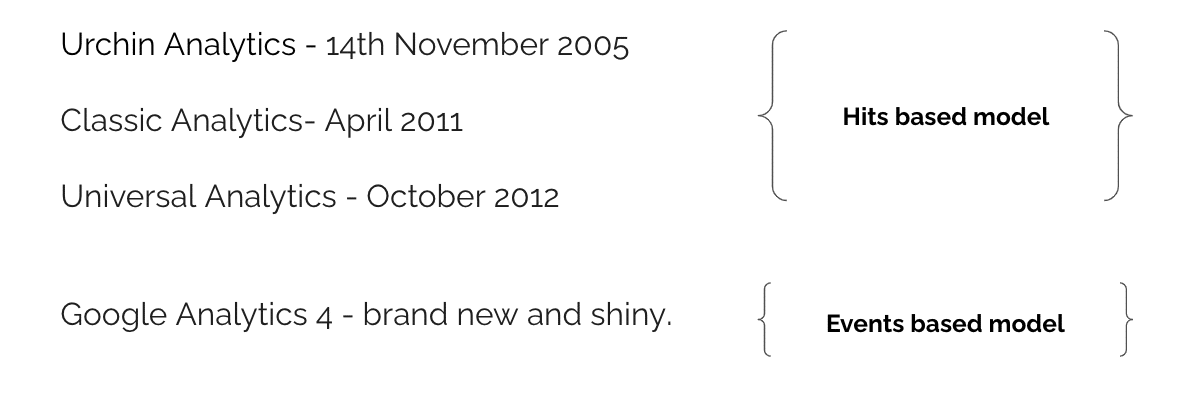
This is an important distinction - with a new data model focused on events, the interface and reporting tools also put events front and centre, helping users of the platform focus on and get better data on macro conversion performance over the old micro conversions setup, with the likes of pageviews, sessions times and bounce rates.
So not only will we all have to get to grips with a brand new system, we will have to reimagine our own analysis, turning our attention to the bigger picture - the customer-centric interactions that truly drive business objectives.
- From pageview counts to events per page focus - pageviews are a vanity metric. We should focus on the interactions on each page instead to see how effective the website is.
- From sessions to engaged sessions - instead of focusing on the number of overall sessions, we should focus on engaged users as they are the users that matter.
- From broad segments to specific audiences based on engagements with the site.
Here are some introductory insights as to what the new platform holds for users moving forward.
So what is GA4?
GA4 takes Analytics of old and merges its seamlessly with Firebase (for apps) so you have a one stop shop for all your online analytics needs
And there have been changes. A lot of changes. I’ve been using Google Analytics daily for over 12 years, and my first look at GA4 was eye opening, and I’ve only just scratched the surface of all the changes and new features.

Here’s some of the coolest changes I’ve seen so far!
- New interface: Gone is the old style interface based on the ABC reporting model of Acquisition, Behaviour and Conversions, to a far more interactive dashboard style focused on the customer journey to and through your website or app.
From the old graph and metrics style:
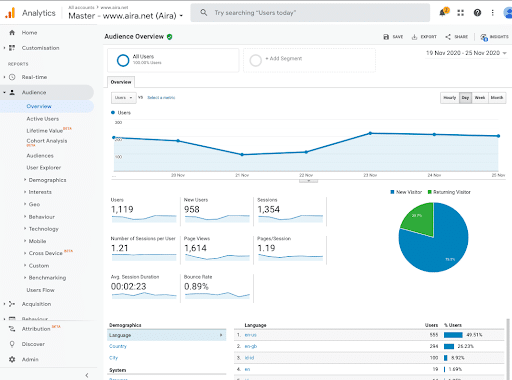
To the new interactive, customer-centric dashboard style:
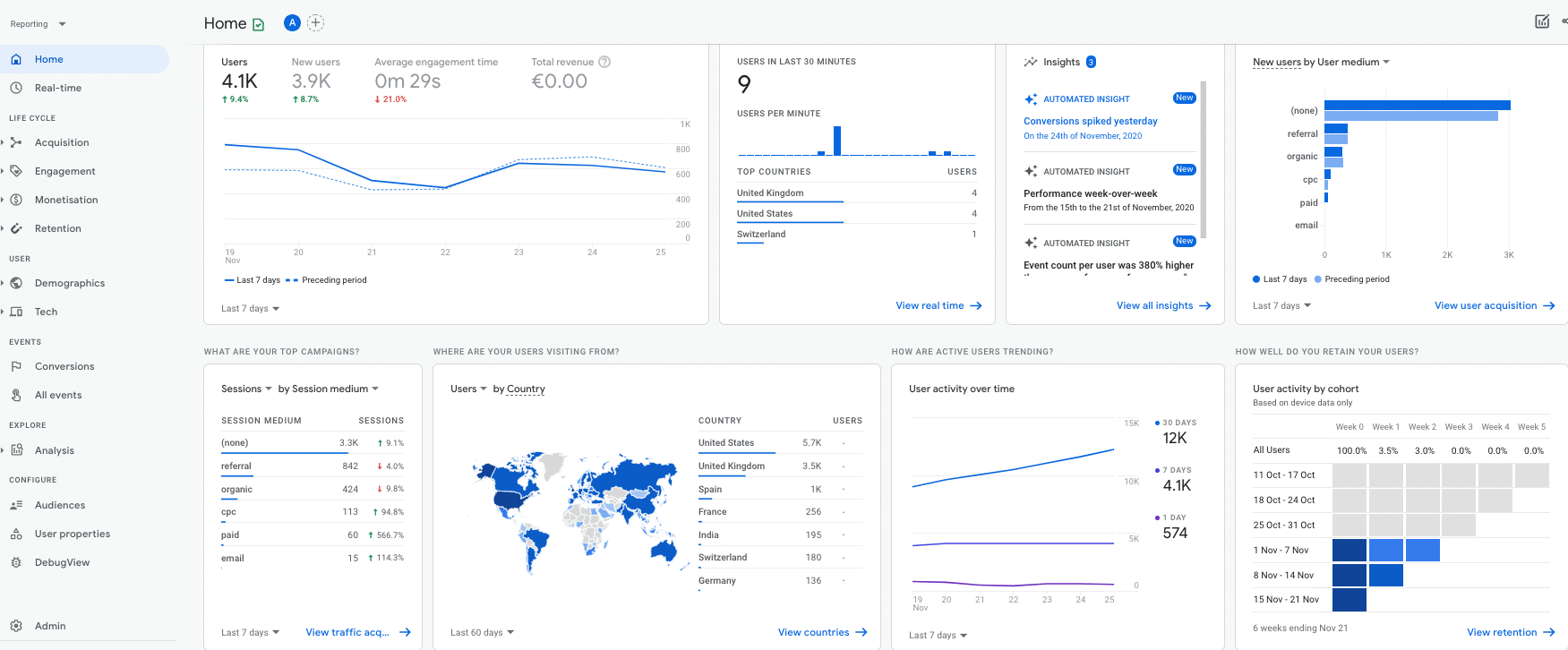
This single change will be felt most by regular users who like certain reports and metrics, many of which have been replaced for this new age of analytics.
Good riddance bounce rate! But that's not all, here are some missing elements I’ve found (or not as the case may be): Details below accurate as of 4th January 2021.
|
Bounce Rate |
Removed |
|
Conversion Rate |
TBC |
|
Page load times |
Removed |
|
Average session duration |
Replaced with average engagement time |
|
Google Ads, GSC & social report sections |
TBC |
Automatic measurement: GA4 is geared up towards automation and ease of use. Google has simplified the set-up further by including a range of event types as automatically collected via the GA4 data streams.

Now pageviews, scroll tracking, outbound clicks, site searches, video tracking and file downloads are all included as standard!
That leads me to the far simpler setup needed to get rolling with GA4....
GA4 setup: GA can be complicated for less experienced analytics users to set up, but not so with GA4. If you use Google Tag Manager, you can add one simple configuration tag and bam, you’re straight into a magical world of events-based data goodness.
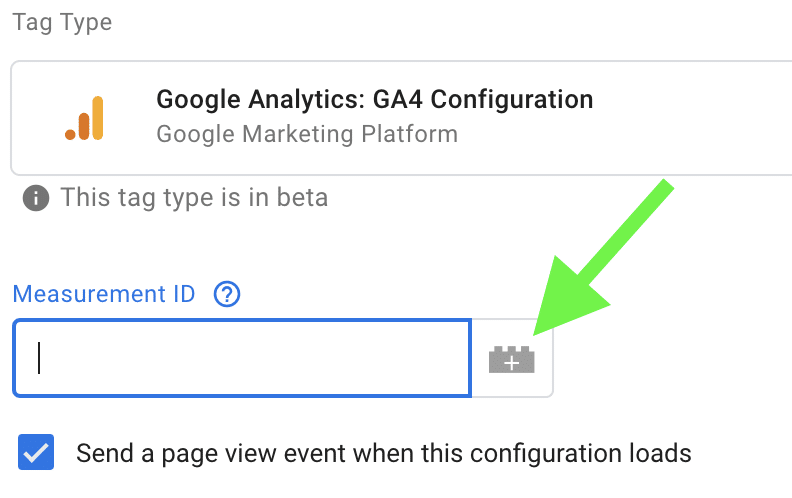
Debugging view: And with a new GTM preview mode and the debugging view in GA4, you can ensure your setup is working correctly, both simply and quickly. This feature will be even more useful when you look to create more advanced events setups.
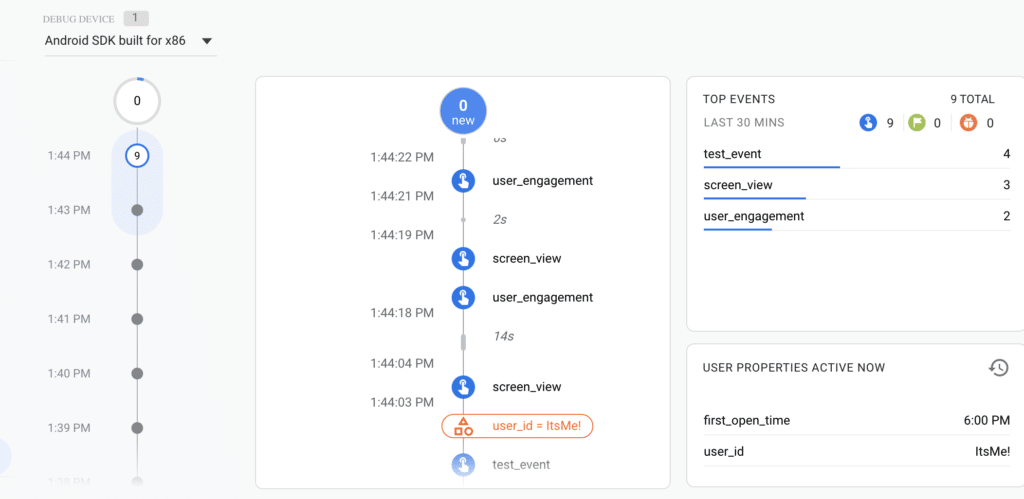
Real Time: This has been beefed up to provide more metrics and data points so you can get a better view of current website usage. This could be crucial for the identification of issues during key periods such as Black Friday sales or new product launches for ecommerce websites.
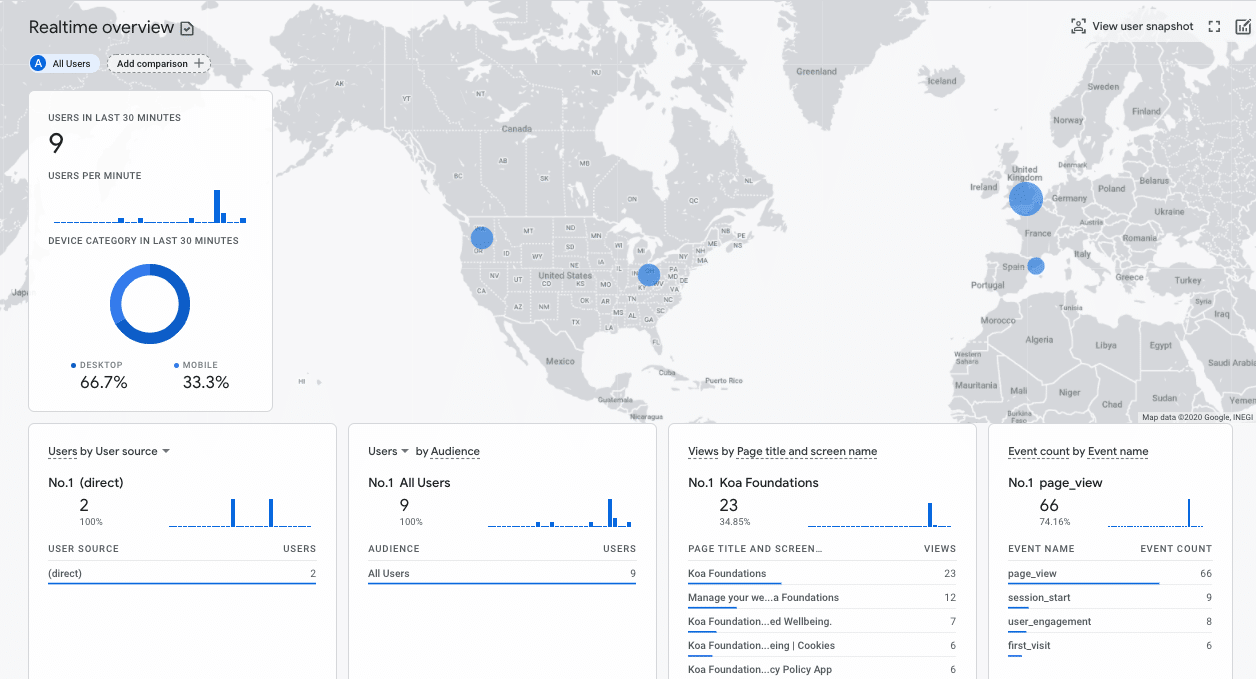
Speed and sampling: GA4 is fast! Like Usain Bolt fast compared to the plodding middle aged weekend jogger that Google Analytics can be when surfacing chunky amounts of data.
Gone are the days of the loading bar crawling along as GA grabs a hefty chunk of data that ends up being sampled.

Sampled data in GA4 is no more - you will get all of the data from your site or app as collected as the new model does away with sampling for all standard reports.
Conversions: Strictly speaking conversions are no more - it's all events. But you can convert selected events into conversions and these are far more flexible compared to Analytics of old. Instead of a limit of 20 conversions total per view in GA, you can now have up to 30 slots per property, and these can be turned on and off, with off goals not counting towards your limit of conversions. (Sidenote - views are no more! But let's not get bogged down here.)
That’s great for seasonal or campaign-based goals.
Events are more prominent in GA4 but have changed too! Gone is the previous setup of the Event, Event Category, Event Action and Event Label. In are event_name, and up to 20! event_parameters.
Audience Builder: Delving in a little further to some of the new features, we can see that the traditional segments of past versions have been replaced by audiences. You can build any audience, including audiences representative of your buyer personas, using a combination of dimensions and metrics as you could with segments but you can now go much further.
These audiences can be used with all features and the data shared across reports. So you could build audiences such as users who completed checkout within five minutes and use that to compare against users who entered checkout but didn’t complete.
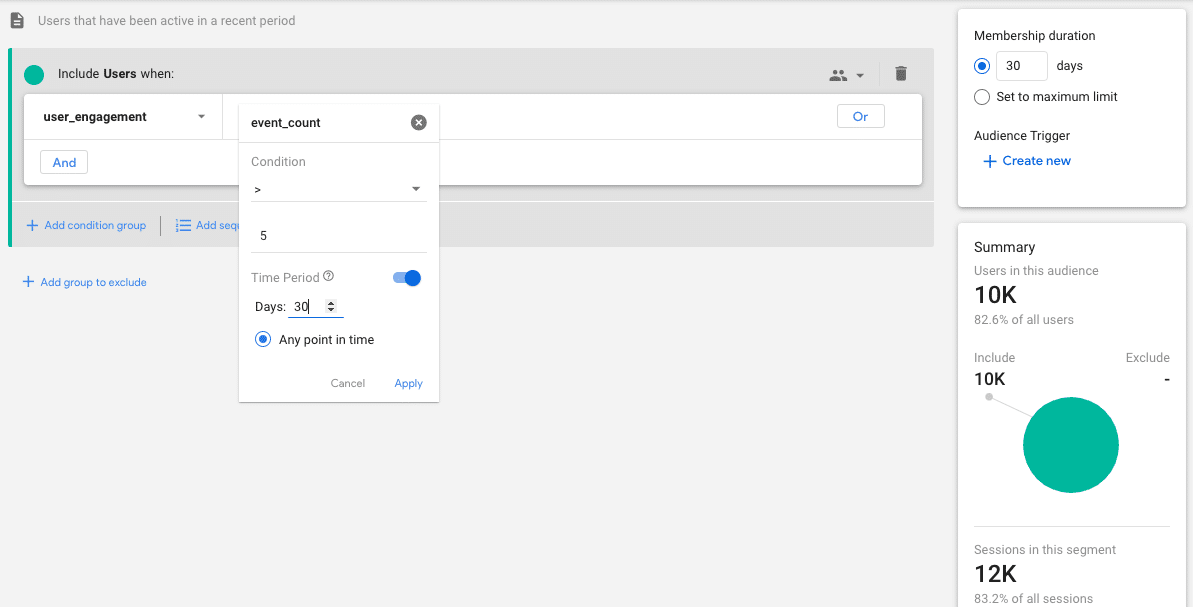
Pathing reports: behaviour and event flows have been merged into this feature, Which gives you a clear visual representation of the customer journey to a completed action.
Coupled with the ability of going into minute detail, GA4 goes a step further and shows this journey back to front you can see all the steps a site visitor took to get to the event, from the event. This is immensely useful to understand performance and work out the most effective paths to success.
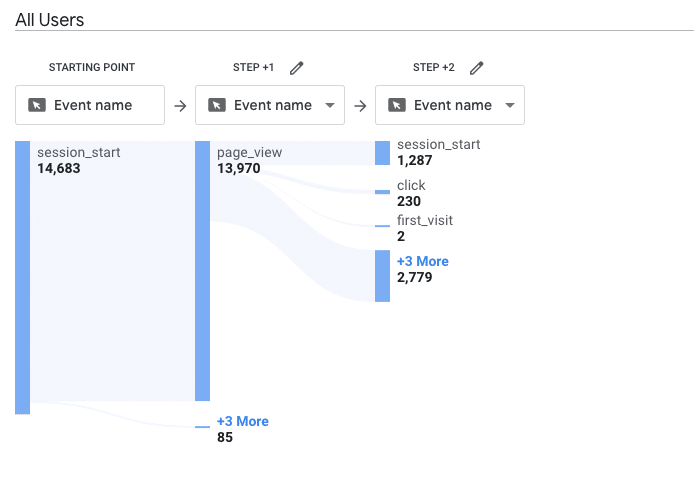
Funnel reports: have been improved massively with on the fly data capabilities so you can analyse any website journey element instantly and understand how effective your site is at getting users to complete a goal action.
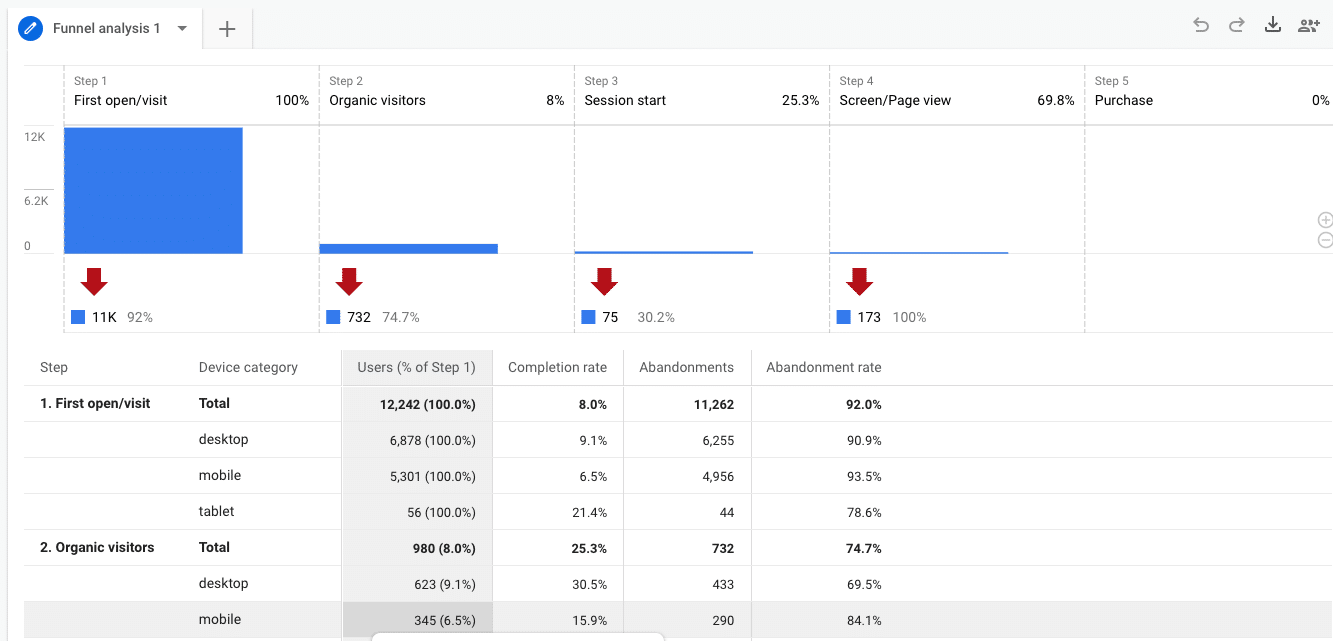
Projections: Saving the best new feature for last - GA4 will use artificial intelligence and machine learning to provide you with a range of projections - from traffic, to audiences most likely to convert. That information can be shared with other channels but the potential here is huge.
Imagine being able to target users as an ecommerce company, based on their behaviour and the endless benefits possible - from better targeted advertising to greater stock control.
This (if it works! Still a big if) could close the customer journey flywheel for marketers, by providing data on all elements of a user lifecycle and allowing you to harness the power of AI and machine learning to continually improve your site, app and marketing campaigns so they convert time and time again.
Again the above features are just the tip of the iceberg, and I wanted to give you insight into why GA4 is going to be a complete sea change in Analytics. I haven’t even touched upon cross-device reporting and GA4 being ‘futureproof’ in terms of cookies and data protection - that’ll wait for the follow-up blog...
The next steps
You may be reading this thinking ‘great, where do we sign up?’ Well, it is recommended to proceed with caution! Don’t rush to move over to GA4.
Why? Well the platform is still under heavy development - things are likely to be unstable as Google continues to work on the product, hence the quieter launch!
We can also see that elements such as ecommerce tracking, products and filters are not fully integrated yet.
Crucial too, it seems the interface still only has a basic reporting function - more elements are being rolled out week after week. Many account linking elements are also missing, such as the Google Search Console integration, which is not there yet and Google Ads reporting was only rolled out a couple of weeks ago.
Coupled with that and the fact it is a shiny new toy, there is understandably little support documentation out there. It would be like trying to build a Lego Death Star model with no instructions - not impossible but very, very difficult indeed.
Oh and for those who use Google Data Studio to report, the data connector with GA4 is very limited still.
Aira’s approach - dual tagging
Ok, so maybe we shouldn’t jump on board right away, but we can dual tag.
GA4 can be tagged simultaneously with your current setup (with just the addition of one GTM tag!) and you can explore the new platform, safe in the knowledge that your precious data is being collected ready for when GA4 is ready to take over the analytics world.
This approach is exactly what Google suggested at launch:
‘The new Google Analytics is now the default experience for new properties and is where we’re investing in future improvements. We know there are capabilities many marketers need before fully replacing their existing Analytics setup, so we encourage you to create a new Google Analytics 4 property (previously called an App + Web property) alongside your existing properties. This will allow you to start gathering data and benefit from the latest innovations as they become available while keeping your current implementation intact.
Vidhya Srinivasan - Google Analytics’ Big Boss
Note for those of you who are setting up Analytics for a brand new website - GA4 is now the default platform so you won’t be able to wait. Hey, at least you’ll be seen as trendsetters (and we’re here to help!).
So there you have it, like a ship captain who can see a perfect storm of data brilliance brewing on the horizon, get yourself ready for GA4 - a complete and utter sea change to how you have collected and reported on your online marketing data. It will be worth the wait.
If you have any questions on GA4 or would like to know more about a future rollout, please email me at brendan.gilbert@aira.net, get in touch with the Aira team or find us on Twitter to chat analytics, SEO and digital marketing.
From November 2020 Googlebot is supporting crawling over HTTP/2. Initially this will be for ‘select sites’, with a plan to gradually increase its coverage.
But what exactly is HTTP/2, what are its benefits and how can you implement it on your website?
What is HTTP/2?
Most servers are currently configured to HTTP/1.1, which has been used for the last 20 years or so. HTTP/1.1 only allows you to make single server requests, one at a time, meaning that the client has to make multiple requests for resources in order to successfully render the page, which can take a lot of time if there are a lot of resources.
There are two types of HTTP server requests, GET and POST. GET requests are usually used to request information from the server to the browser (like a web page or an image). POST requests are usually used for more secure requests such as receiving a form submission from a contact form.
HTTP/2, also known as ‘h2’, allows you to make multiple requests for different file types, such as html, jpeg, css, js, etc.
According to Google:
‘it's the next major version of HTTP...HTTP/2 is much more robust, efficient, and faster than its predecessor, due to its architecture and the features it implements for clients (for example, your browser) and servers.’
Benefits of using HTTP/2
Search Engine Land has called HTTP/2 ‘one of the greatest advancements in web technology in the past 20 years’.
And there are some pretty significant benefits to consider, which you can see briefly outlined here:
- HTTP/2 reduces the number of requests to the server, reducing the resources a server needs to use
- It reduces load time, so offers a better user experience and the SEO benefits that entails
- It reduces latency (the time it takes for a network connection to open over a distance - one of the main issues affecting web speed and a major reason for Google to develop HTTP/2)
- It enables much more efficient crawling for websites and saves crawl budget
How to implement HTTP/2
If your server supports HTTP/2 and Google already crawls a lot from your website, you might be eligible for a connection upgrade already, without having to do anything.
But if you want to make sure you can take advantage of the expected benefits of HTTP/2, you’ll need to ensure the following:
- Your website is already on the HTTPS protocol. If not you will need to move from HTTP to HTTPS
- Your web server is able to support HTTP/2
- Your server is configured to use HTTP/2
This post from Cloudflare details lots of ways to check whether your site supports HTTP/2.
It’s also worth noting though that Google have said they will not be crawling every HTTP/2-enabled site over h2, if there is ‘little to no benefit...for example those with limited qps’ (queries-per-second).
Summary
HTTP/2 will be with us very soon, and although Google state there’s ‘no explicit drawback’ to remaining on HTTP/1.1, the benefits mentioned above suggest that it’s well worth getting on board and moving to HTTP/2 now, so that your site can be in the best position to embrace this next step in the evolution of web technology.
Further Reading
Introduction to HTTP/2 - Google
An introduction to HTTP/2 for SEOs - Distilled
HTTP/1.1 vs HTTP/2: What's the Difference? - DigitalOcean
Why Everyone Should Be Moving to HTTP/2 - Search Engine Land
Tools for debugging, testing and using HTTP/2 - Cloudflare
I like to look at websites and online brands the same as I do humans…
You wouldn’t go out for dinner with a randomer you just met on the dodgy side of town (well you might do, but each to their own), so why would you commit to purchasing or trusting information from a website you’ve just heard of that popped up on a weird Instagram sponsored post?
Becoming a trustworthy person and website takes both time and effort, and I’m going to try and explain how to build trust online on your own website, or a client website, while building links!
Make sure your content and information is valuable
Making sure your website has valuable information and interesting content is key to success when building authority online. If it doesn’t cover the basics of what your company does and sells, then Google - and humans - won’t look at it as a legitimate site.
Take Aira’s website, for example - you land on the page and you know exactly what we do and who we are. When you move through to the blog you start to get an understanding of what we specialise in and why we do what we do - essentially, we’re selling ourselves and sharing information and content that is valuable to the user.
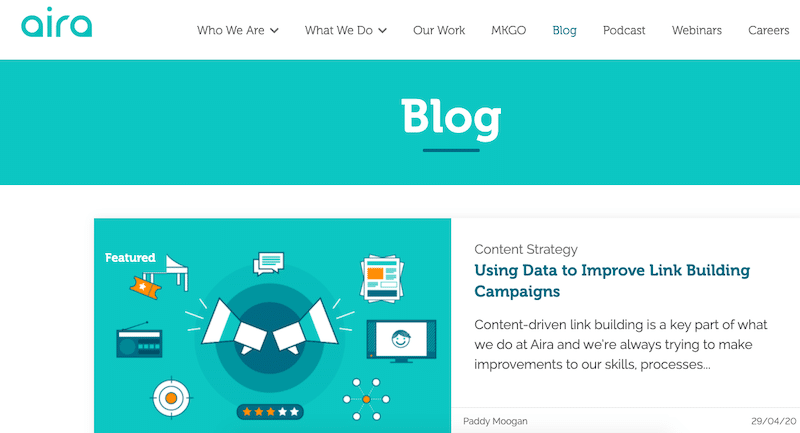
Once the basics are covered, such as a decent blog, you can start to get a little more creative - what about ideating and doing research, analysing data and then generating content to create a story that sparks conversation?
This can be anything from interactive in-depth research to a simple top 10 blog post or listicle (you can read more about ideation here). What matters at this point is that you’re generating content that is both interesting and valuable to your customer/audience.
Share with the right people to build authority
Once you’ve generated the content with a designer or developer, it’s important to do something with it. You wouldn’t make a meal and leave it sitting on the side and not eat it? So don’t spend all of your time and effort generating ideas, pulling together data and writing copy to just leave it sitting on the site.
You now need to get this story into a press release and send it to the right journalists to build some juicy links in order to gain authority online.
Easier said than done…
I’m going to take you through the steps us digital PRs follow at Aira in order to make sure we’re approaching the right journalists with our stories and therefore generating links.
1) Nail your stories and angles
Take some time to really analyse the content you’re generating to establish the interesting hooks and stories that are in it.
Take this content, for example. When analysing this we could see far more angles than we originally thought.
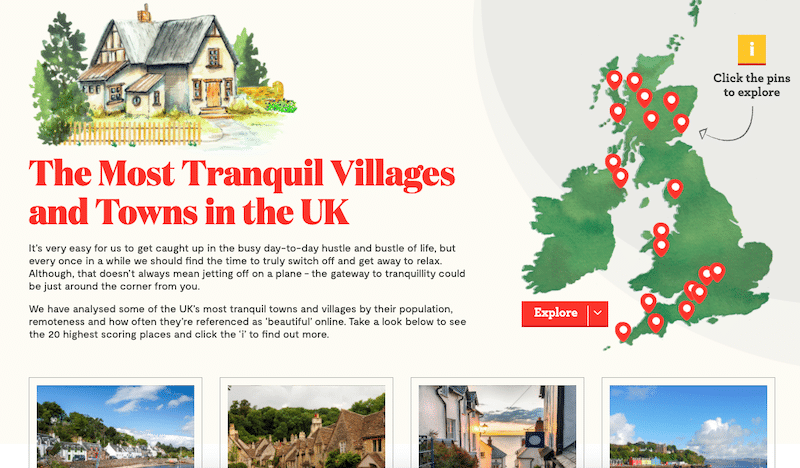
The obvious one: ‘The most tranquil villages and towns in the UK’, but there were also angles such as: ‘Top staycation destinations in the UK’ and ‘Best mini-moon destinations’, meaning that our story was relevant to various sectors of the press
2. Build more than just a media list
Media lists in PR are 101 - everyone builds them, they’re a pretty standard practice if you work in the industry. But, this is probably the most important part of building your authority online and generating links.
You have to make sure you’re going to the right people who, a) are going to want to cover your story, and b) are the best people to approach.
For example, a freelancer may write for a big top-tier publication, such as the Independent and they may look as if they’d be interested in featuring your story, but it doesn’t mean they are the best person to approach - a freelancer then has to pitch the story to the editor/PoC at the publication and it could be a long waiting game.
It’s better to approach the key contact at the news outlet - such as an editor or even the newsdesk (it does work!!)
Here are just a few simple steps to building a media list:
- Establish sectors of the press you want to approach: nationals, lifestyle, regionals, HR etc
- Then fill in the key publications within those sectors that would feature a similar topic to yours - tools such as Vuelio and Gorkana are great for this, but even just a manual Google search can find a new site you haven’t seen before
- Once you’ve done this, a manual search on said sites is key - go to the search bar of the publication and search for the topic of your story. For example, ‘holiday destinations in the UK’ or ‘top TikTok accounts’ and manually look through the types of journalists that are already talking about your topics, and add them to your list
- Now it’s time for the media databases to do their thing - head on over to the likes of Gorkana, Vuelio or Roxhill to find the journalist’s email address and details. If you’re struggling, do a quick search on Twitter or drop them a DM
- At this point, you should have the bulk of your media list, but you still need to do the most important bit (and actually it doesn’t matter if you do this at the start or end of building your list) - pop some of your competitors’ campaigns into the likes of Ahrefs, Buzzsumo and Majestic to see if they’ve gained any coverage from journalists that aren’t already on your list
3. Sell your story during outreach
Sometimes looked at as the easiest part - in outreach essentially you’re just sending an email. But it needs to be super succinct and clear. Here are a few tips to follow:
- Create a subject line that you can envisage as a headline
- Sell the story within the first few sentences of the pitch email
- Provide the key stats and angles that specific journalist needs - for example, if you’re pitching to a Scottish regional, make sure they have specific data for their readership
- Give them absolutely everything they need to feature the story - images, data, press release
- If you don’t hear back, give them a few days before you follow up with them - remember they’re just a human with busy inboxes and life pressures, too
Gaining results to build authority
After the above process has taken place, it should hopefully lead to some juicy coverage and links across a variety of the sites you’ve pitched into, meaning that they trust the research, knowledge and information from your content.
From generating links on other trusted top-tier sites, your website can gain traffic from people who trust them as a source. This, alongside a mixture of other digital marketing and SEO tactics, can boost domain authority and lead to an increase in rankings.
Before we delve into what an inbound marketing campaign should look like, we should briefly cover what inbound marketing is.
Inbound marketing attracts potential customers by offering relevant content, allowing them to understand and solve their problems throughout the buyer’s journey.
Inbound marketing is different from outbound marketing, which is more traditional and seeks to interrupt potential customers, rather than ensuring you are found by the people who are already searching or shopping for your product or service (see our inbound vs outbound marketing blog for further insight).
An overarching inbound marketing strategy is usually divided into separate inbound marketing campaigns. HubSpot defines inbound marketing campaigns as ‘concentrated efforts that align your marketing channels around a single message and goal’, through a promoted content offer relevant to your potential customer. But what should an inbound marketing campaign look like?
Planning an inbound marketing campaign
An inbound marketing campaign is a content-driven activity. The main goal is to attract new leads to your business by providing them with the information they want.
In order to devise a successful inbound marketing campaign, you will need to complete some key planning tasks including setting goals or KPIs, understanding the buyer persona you are targeting, and creating a content strategy.
Goals
Firstly you need to outline your goals or KPIs for this campaign, to ensure your campaigns are measurable and focused on driving results. Using SMART goals you are able to create Specific, Measurable, Attainable, Relevant, and Timely goals.
To help you create your own SMART goals, take a look at the points below, in this case for growing blog traffic:
1. Is your wording specific enough? Example: ‘We want to increase the volume of traffic to our blog by targeting two different buyer personas in four blog posts per month
2. Are your goals measurable? Example: We’re aiming for a 5% traffic increase
3. Are your goals attainable? Example: Blog traffic went up 3% last month after increasing posts published from two to three
4. Are your goals relevant? Example: By targeting our buyer personas and posting more frequently, we’ll not only generate more traffic but we’ll also be providing more relevant content to our audience
5. What is the timescale? Example: By October 2020 we will see a 5% increase in traffic
Buyer persona
You need to identify which of your buyer personas you will be targeting through your inbound marketing campaign. A buyer persona is a projection of your ideal customer, based on data about your current customers and your industry. Using buyer personas has many benefits, including making it easier to create useful content to help improve the quality of your leads, and know which to qualify.
If you haven’t yet developed your buyer personas you can learn more in our post, What is a Buyer Persona?
Content strategy
To help structure your content within your inbound marketing campaign and allow your target audience to make a well-informed decision, you will need to revert back to your content strategy in order to attract your buyer persona, by creating content at the relevant stage of the buyer’s journey in order to engage them.
If you don’t yet have a content strategy, including core topics, subtopics and monthly search volume data, then visit HubSpot’s guide on How to Develop a Content Strategy before you get started.
Setting up your inbound marketing campaign
Now you know your campaign goals, you have your content offer and you know who you’re targeting, you can set up your campaign.
A CRM such as HubSpot or Salesforce will allow you to manage your campaigns, nurture your leads and measure your campaign performance.
Here are the steps you could follow to create your campaign:
1. Create your content offer - as well as ensuring your content is relevant to your buyer persona, you can also create smart content that will allow you to deliver the right information to your audience, depending on their buyer persona and/or factors including location and behaviour. Make sure to structure your content using H1s and H2s and test your content offer and continue to optimise it.
2. Calls to action - you need to ensure your content offer has clear CTAs which link back to your goals and KPIs, e.g. ‘book a demo’ or ‘contact us’. You can also use smart CTAs to ensure relevance.
3. Landing page creation - create your landing page to capture information from potential customers. By filling in a form, your potential customer will be able to download content offers such as ebooks, whitepapers and free demos.
4. Use forms - not all content needs to be gated, however forms will allow you to collect valuable information on your visitors, and by using dynamic fields in forms you will be able to qualify them, with lead-scoring metrics such as company size. This will help align sales and marketing processes too.
5. Segmentation - as your campaign gathers more information about your leads, make sure you segment and effectively manage your contacts. You can do this by building targeted lists and lead scoring. You can also build smart content to nurture your customers through the funnel with marketing automation.
6. Automation - build emails in advance and set up workflows to trigger once a form is submitted. This helps to ensure leads are followed up, by automatically sending them more relevant content, which continues to push them through the buyer’s journey. You can also use automation to improve internal processes - for qualifying leads from your campaign, for example.
7. Campaign promotion - through your content strategy you will know where your prospects spend their time online,, enabling you to deliver your audience the right content at the right time to hit your goals. Promotion could be in the form of email marketing, paid media, or SEO to generate organic traffic. Our blog post on 17 Essential Inbound Marketing Tactics dives deeper into this.
8. Feedback - getting feedback from your customers and leads on your campaign will allow you to continue to develop your inbound marketing strategies and continue to delight your customers.
9. Report on your results - using Google Analytics or CRM reporting tools helps you accurately report on what has and hasn’t worked in your campaign, and also identify improvements.
In summary, an inbound marketing campaign needs to be planned carefully in order to hit KPIs and deliver results.
By delivering the right content at the right time, in the right place, you will be able to attract, engage and delight your prospects and customers, gather valuable lead-scoring information to pass to the sales team, and as a result, grow your business.
By reporting on your results you will gain valuable insights and key learnings that you can use to continue to optimise your campaigns.

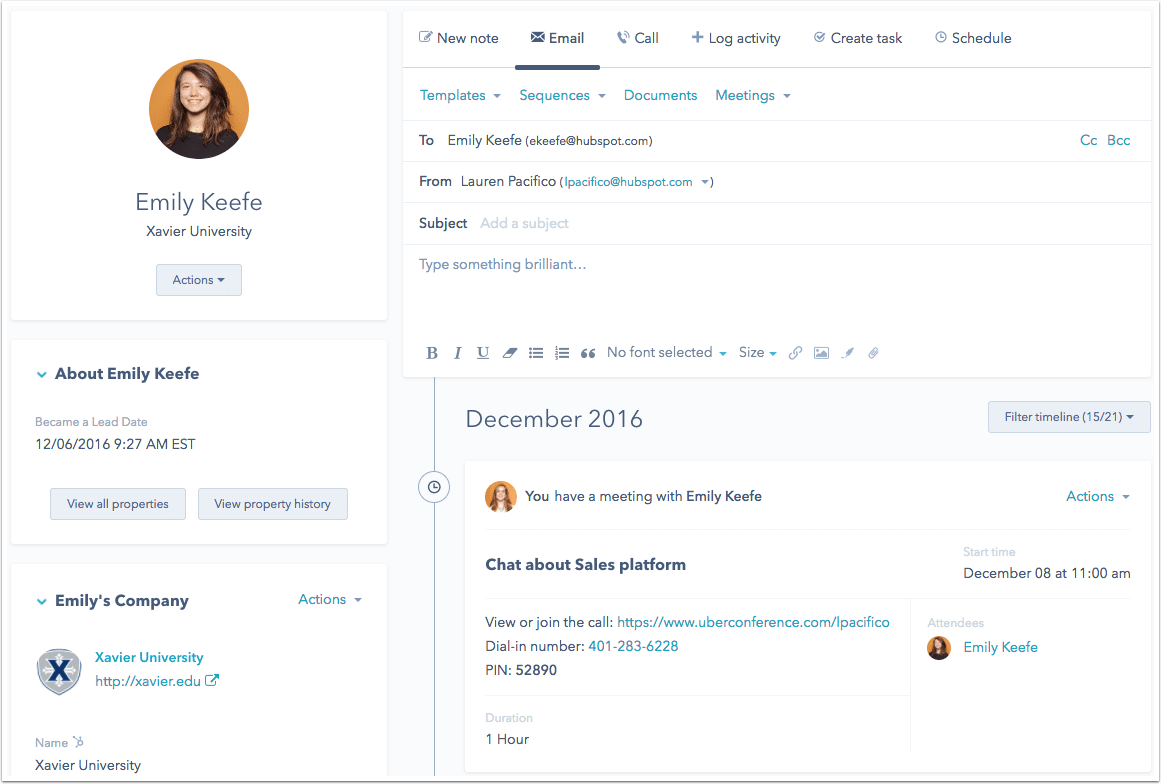 (Source)
(Source)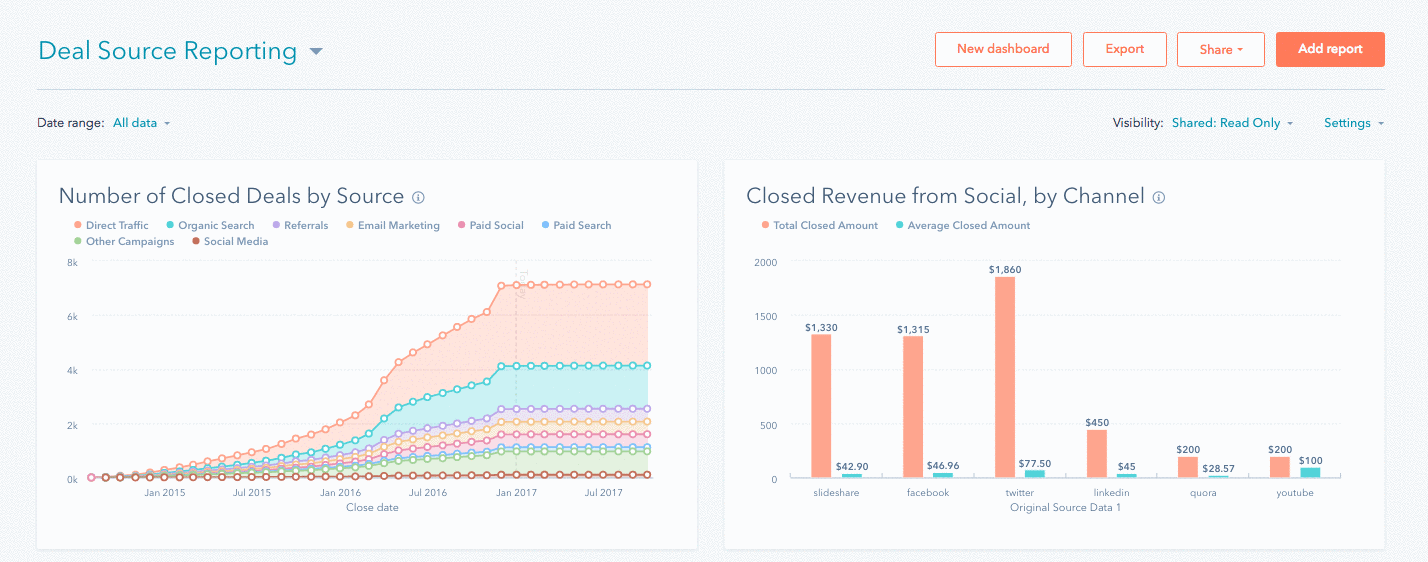 (
(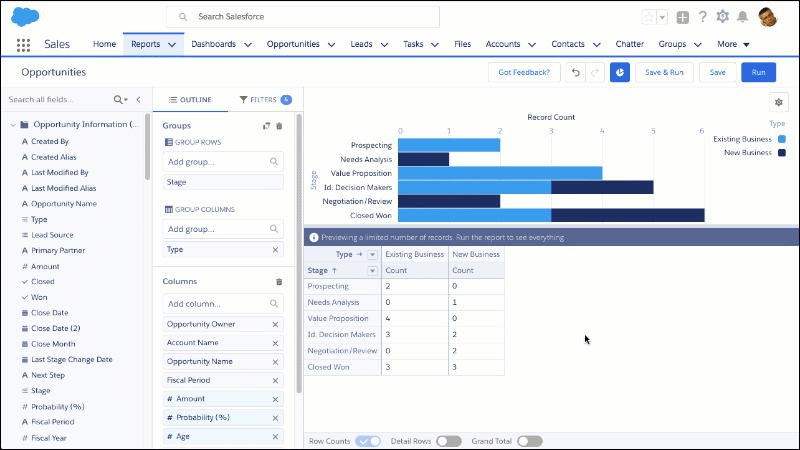 (Source)
(Source)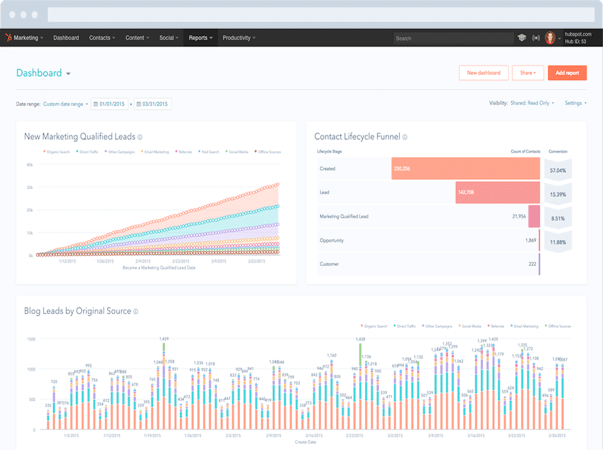 (Source)
(Source)